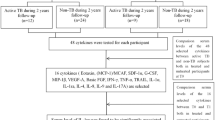Abstract
Serum soluble interleukin-2 receptor (sIL-2R) serves as a marker of disease activity in patients with tuberculosis (TB). However, little is known about its role in latent TB. The aim of this study was to assess the levels of sIL-2R in patients with latent TB and correlate them with the purified protein derivate (PPD) test results. Patients with a diagnosis of latent TB were divided into three subgroups by induration size: <10 mm, 10–20 mm, >20 mm. Blood was collected for sIL-2R assay. Findings were compared to a healthy control group. The study group consisted of 44 patients (68% male) of mean ( ± SD) age 20 ± 10 years, and the control group consisted of 41 subjects (42% male) aged 31 ± 11 years. Comparison of the two groups yielded a significantly higher serum sIL-2R level in the patients (450 ± 224 U/ml vs. 374 ± 30 U/ml, p = 0.03). Mean sIL-2R levels were significantly correlated with the presence of latent TB (p = 0.03), and with purified protein derivative (PPD) subgroups: 387 ± 177 U/ml for induration size <10 mm, NS; 450 ± 238 U/ml for 10–20 mm, p = 0.04, and 605 ± 235 U/ml for >20 mm, p < 0.0001. sIL-2R assay may serve as an additional tool to estimate the extent of the immune response in patients with latent TB.

Similar content being viewed by others
References
American Thoracic Society (1990) Diagnostic standards and classification of tuberculosis: joint statement of the American Thoracic Society and the Centers for Disease Control. Am J Rev Respir Dis 142:725–735
American Thoracic Society, Centers for Disease Control and Prevention (2000) Targeted tuberculin testing and treatment of latent tuberculosis infection. Am J Respir Crit Care Med S221–S247
Aviles Ingless MJ, Cotessotto C, Ontanon RJ, et al (1995) Serum soluble interleukin 2 receptor: a useful indicator of the clinical course in pulmonary tuberculosis. Tuberc Lung Dis 76:130–135
Cantrell DA, Smith KA (1983) Transient expression of interleukin-2 receptors: consequences for T-cell growth. U Exp Med 158:1895–1911
Chan CHS, Lai KN, Leung JCK, et al (1991) T lymphocyte activation in patients with active tuberculosis. Am Rev Respir Dis 144:458–460
Chan CHS, Lai CKW, Leung JCK, et al (1995) Elevated interleukin-2 receptor level in patients with active pulmonary tuberculosis and the changes following anti-tuberculosis chemotherapy. Eur Respir J 8:70–73
Chang SC, Hsu YT, Chen YC, et al (1994) Usefulness of soluble interleukin-2 receptor in differentiating tuberculous and carcinomatous pleural effusions. Arch Intern Med 154:1097–1101
Edwards D, Kirkpatrick CH (1986) The immunology of mycobacterial diseases. Am Rev Respir Dir 134:1062–1071
Ellner JJ, Wallis RS (1989) Immunologic aspects of mycobacterial infections. Rev Infect Dis 11:S455–S459
Hua CC, Chang LC, Chen YC, Chang SC (1999) Proinflammatory cytokines and fibrinolytic enzymes in tuberculosis and malignant pleural effusions. Chest 116:1292–1296
Maurice JL (1975) Delayed hypersensitivity and immunity in tuberculosis. Am Rev Respir Dis 111:243–246
Nelson DL, Rubin LA, Kuman CC, Fritz ME, Boutin B (1986) An analysis of the cellular requirements for the production of soluble interleukin-2 receptor in vitro. J Clin Immunol 6:114– 120
Platt JL, Grant BW, Eddy AA, Michael AI (1983) Immune cell populations in cutaneous delayed hypersensitivity. J Exp Med 158:1227–1242
Porcel JM, Gazques I, Vives M, et al (2000) Diagnosis of tuberculous pleuritis by the measurement of soluble interleukin 2 receptor in pleural fluid. Int J Tuberc Lung Dis 4:975–979
Rajalingam R, Mehra NK, Pande JN, et al (1996) Correlation of serum interleukin-2 receptor-alpha levels with clinical manifestations in pulmonary tuberculosis. Tuberc Lung Dis 77:374– 379
Rubin LA, Kurman CC, Fritz ME, et al (1985) Soluble interleukin-2 receptors are released from activated human lymphoid cells in vitro. J Immunol 135:3172–3177
Rubin LA, Jay G, Nelson DL (1986) The released interleukin-2 receptor binds interleukin-2 efficiently. J Immunol 137:3841–3844
Smith KA (1998) Interleukin-2: inception, impact, and implications. Science 240:1169–1176
Takahashi S, Setoguchi Y, Nukiwa T, et al (1991) Soluble interleukin-2 receptor in sera of patients with pulmonary tuberculosis. Chest 99:310–314
Tsao TCY, Huang CC, Chiou WK, et al (2002) Levels of interleukin-2 receptor alpha for bronchoalveolar lavage fluid and serum were correlated with clinical grade and treatment of pulmonary tuberculosis. Int J Tuberc Lung Dis 6:720–727
Author information
Authors and Affiliations
Corresponding author
Rights and permissions
About this article
Cite this article
Shitrit, D., Izbicki, G., Shitrit, A.BG. et al. Role of Soluble Interleukin-2 Receptor Levels in Patients with Latent Tuberculosis. Lung 184, 21–24 (2006). https://doi.org/10.1007/s00408-005-2558-2
Accepted:
Issue Date:
DOI: https://doi.org/10.1007/s00408-005-2558-2




